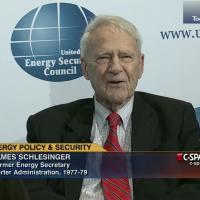James Schlesinger
(academic, spook, deep state operative) | |||||||||||||||||||||||
|---|---|---|---|---|---|---|---|---|---|---|---|---|---|---|---|---|---|---|---|---|---|---|---|
 | |||||||||||||||||||||||
| Born | James Rodney Schlesinger 1929-02-15 New York City, New York, U.S. | ||||||||||||||||||||||
| Died | 2014-03-27 (Age 85) Baltimore, Maryland, U.S. | ||||||||||||||||||||||
Cause of death | pneumonia | ||||||||||||||||||||||
| Alma mater | Harvard University | ||||||||||||||||||||||
| Religion | Jew | ||||||||||||||||||||||
| Children | 8 | ||||||||||||||||||||||
| Spouse | Rachel Line Mellinger | ||||||||||||||||||||||
| Member of | Association of Former Intelligence Officers, Belfer Center for Science and International Affairs, British-North American Committee, Center for Strategic and International Studies, Homeland Security Advisory Council, Mitre Corporation, RAND/Notable Participants | ||||||||||||||||||||||
| Party | Republican | ||||||||||||||||||||||
USDSO, DCI, RAND, US Defense secretary
| |||||||||||||||||||||||
James Rodney Schlesinger was a US Deep state operative who had various roles including US Secretary of Defense and Director of Central Intelligence.
Contents
Background
Schlesinger was born in New York City, the son of Jewish parents, Rhea Lillian (née Rogen) and Julius Schlesinger.[1] His mother was a Lithuanian emigrant from what was then part of the Russian Empire and his father was of Austrian Jewish descent. He converted to Lutheranism in his early 20s. Schlesinger was educated at the Horace Mann School and Harvard University, where he earned a B.A. (1950), M.A. (1952), and Ph.D. (1956) in economics.
Career
Between 1955 and 1963 Schlesinger taught economics at the University of Virginia and in 1960 published The Political Economy of National Security. In 1963, he moved to the Rand Corporation, where he worked until 1969, in the later years as director of strategic studies.
"Someone once said that war is hell, and peace is heaven. But we know that the opposite is true: War is heaven, and peace is hell."
James R. Schlesinger, honorary chairman of the OSS Society and member of the AFIO, in a speech to the Military Order of the Carabao.[2]
"Oil Crisis"
Schlesinger became a symbol of the long gas lines that “marked the beginning of the end of the Presidency of Jimmy Carter,” wrote energy analyst Daniel Yergin.[3]
Affiliations
- Belfer Center for Science and International Affairs International Advisory Council
- Committee on the Present Danger (1976 version)
An appointment by James Schlesinger
| Appointee | Job | Appointed | End |
|---|---|---|---|
| William Colby | Head of Clandestine Branch ? | 1973 | September 1973 |
Related Quotation
| Page | Quote | Author | Date |
|---|---|---|---|
| Australia/1975 coup d'état | “There were a number of points of tension between Whitlam's government and the United States intelligence apparatus. Whitlam had close ties with the United States, in 1964 receiving a "Leader" travel grant from the U.S. Department of State to spend three months studying under U.S. government and military officials.
After coming to power, Whitlam quickly removed the last Australian troops from Vietnam. Whitlam government ministers criticised the US bombing of North Vietnam at the end of 1972. The US complained diplomatically about the criticism. In March 1973, US secretary of State William Rogers told Richard Nixon that "the leftists [within the Labor Party would] try to throw overboard all military alliances and eject our highly classified US defence space installations from Australia". In 1973, Whitlam ordered the Australian security organisation ASIS to close its operation in Chile, where it was working as a proxy for the CIA in opposition to Chile's president Salvador Allende. Whitlam's Attorney-General Lionel Murphy used the Australian Federal Police to conduct a raid on the headquarters of the Australian Security Intelligence Organisation (ASIO) in March 1973. CIA Chief of Counter-Intelligence, James Angleton, later said Murphy had "barged in and tried to destroy the delicate mechanism of internal security". Australian journalist Brian Toohey said that Angleton considered then Australian Prime Minister Gough Whitlam a "serious threat" to the US and was concerned after the 1973 raid on ASIO headquarters. In 1974, Angleton sought to instigate the removal of Whitlam from office by having CIA station chief in Canberra, John Walker, ask the director general of ASIO, Peter Barbour, to make a false declaration that Whitlam had lied about the raid in Parliament. Barbour refused to make the statement. In 1974, Whitlam ordered the head of ASIO, Peter Barbour, to sever all ties with the CIA. Barbour ignored Whitlam's order and contact between Australian and US security agencies was driven underground. Whitlam later established a royal commission into intelligence and security. Jim Cairns became Deputy Prime Minister after the 1974 election. He was viewed by US secretary of state Henry Kissinger and defence secretary James Schlesinger as "a radical with strong anti-American and pro-Chinese sympathies". The US administration was concerned that he would have access to classified United States intelligence. Whitlam instantly dismissed ASIS chief WT Robinson in 1975 after discovering ASIS had assisted the Timorese Democratic Union in an attempted coup against the Portuguese administration in Timor, without informing Whitlam's government. Whitlam threatened to reveal the identities of CIA agents working in Australia. He also threatened not to renew the lease of the US spy base at Pine Gap, which was due to expire on 10 December 1975. The US was also concerned about Whitlam's intentions towards its spy base at Nurrungar.” | Wikipedia | 2022 |
References
- ↑ Encyclopedia of the Central Intelligence Agency - W. Thomas Smith - Google Books
- ↑ Jan. 28, 2003, Village Voice, 'The Empire Strikes Back'
- ↑ https://www.washingtonpost.com/national/james-r-schlesinger-cia-chief-and-cabinet-member-dies/2014/03/27/e4a8f01c-b5bb-11e3-8020-b2d790b3c9e1_story.html